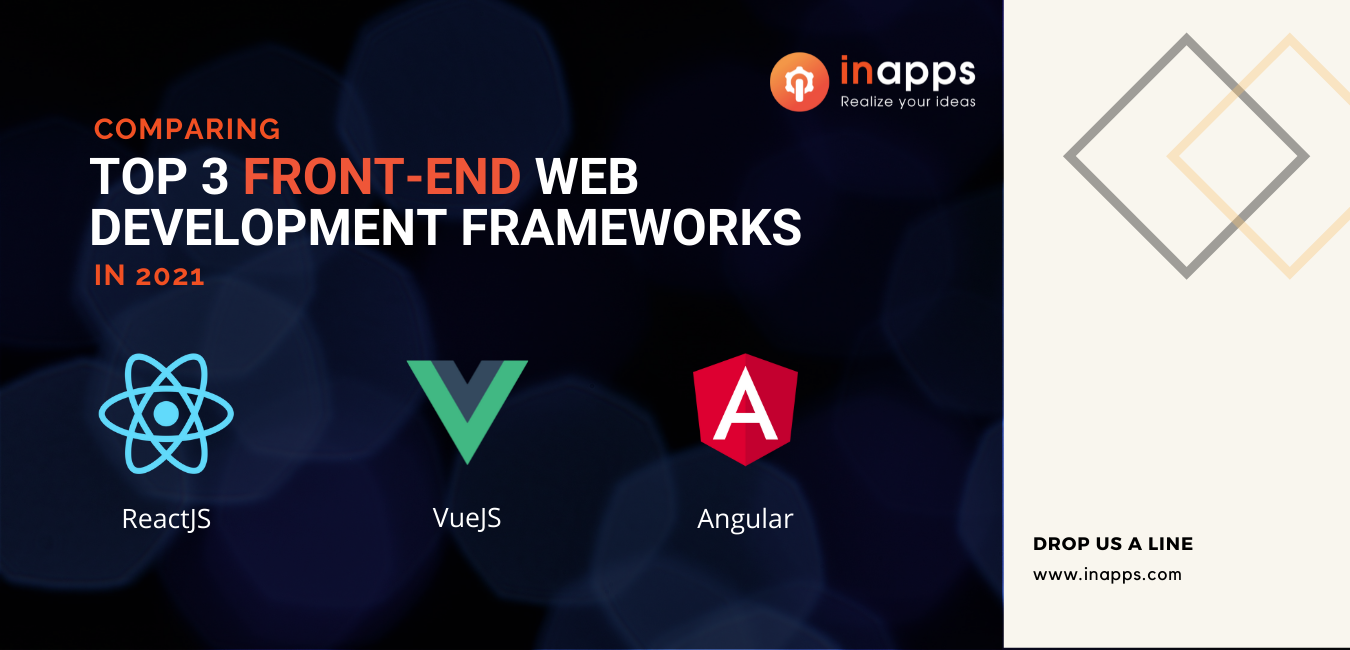- Home
- >
- Mobile apps development
- >
- Front-end website development: Comparing Top 3 Javacript frameworks in 2022
What to look out for for your next front-end web development project? What is the best front end frameworks 2022? The top 3 web javascript frameworks 2022 are here to help you decide.
In today’s digital era, online presence is a must-have for any business. If you don’t have a website, you’re in trouble today. Every business needs a clean, easy to navigate, functional, and appealing website to attract customers and hopefully maintain their interest.
This is where Front-end development comes in. Seamlessly done can flourish your business, but the opposite not only creates an unpleasant appearance but also drives away business.
If you are asking yourself what front-end frameworks are and why we need them, keep reading to find the answer!

Javascript frameworks 2022 – best frontend framework 2022
Our previous post covered the importance of building a solid foundation – the back-end web.
In this week’s column, you’ll get a hold of four key points:
- Explanation of front-end web development
- Comprehensive comparison of the top three JavaScript framework 2022 for front-end web development.
- Hiring front-end web developers: Options + Rate across regions
- Why Vietnam is an offshore software development powerhouse?
Now, without further ado, let’s jump right into web front-end development.
In case you miss it: Building a strong foundation – the back-end web
Definition of front-end web development
Web developers use front-end frameworks to facilitate their jobs. These software packages generally provide:
- Pre-written or reusable code modules.
- Industry-standard front-end technologies.
- Multiple ready-made interface blocks.
All of these components make it easier for web developers to develop sustainable web applications and UIs without the hassle of coding every section, function, or object from scratch.
Additionally, these frameworks contain specific development instruments such as a grid – making it easier to place and position the UI design components, pre-defined font settings, other standard building blocks (for example, buttons, navigation bars, side panels, forms, etc.).
Up to this point, there are many different front-end frameworks, and most of them use JavaScript as their source language. Finding which is the best to use can be pretty much time-consuming because you have to consider numerous factors and a lot of nuances.
If you’re searching for a detailed comparison of the most popular and powerful Javascript frameworks 2022, you’ve come to the right place.
You may also enjoy: Front-end vs. Back-end: Comparison
Top 3 best frontend javascript frameworks for web development in 2022

Front end javascript frameworks – top front end frameworks 2022
ReactJS

Web front end framework
Initial release: 2011
In a nutshell: ReactJS is one the most popular frameworks for web front-end development out there. Developed by Facebook initially in 2011, ReactJS is a JavaScript component-based library featuring JSX syntax.
However, until 2013, it took a turn to become an open-source library – making it slightly different from the original definition of a web front-end development framework.
When to use ReactJS?
If your web development projects are complex and have various components with different, usually changing states like:
- active/inactive navigation items
- accordion sections expanded/collapsed
- dynamic inputs
- buttons active/disabled
- user login
- access permissions
Then these types of projects might be suitable for ReactJS. This framework lets you have more control, manage those changing states easier, last but not least, dynamically present different views to the user according to the state information.
Added to that, ReactJS can even perform more power when combined with a patterned flux library like MobX or Redux.
When not to use ReactJS?
The biggest reason for teams not opting for React is if they’re not ready to code on pure JavaScript. You might avoid React for web front-end development if your team:
- Has front-end developers that are familiar with CSS
- Has front-end developers that are familiar with HTML but aren’t comfortable coding with JSX
In our experience, JSX can be more intermediate level for some developers. However, it can be learned quickly, but make sure your team is ready.
What are real-life projects developed with React?
Some popular websites that use React.js in production are Netflix, Facebook, Netflix, UberEats, Khan Academy, Pinterest, Airbnb, Reddit, BBC, etc.
You might also find this insightful: Must-have traits of a good React developer.
VueJS

Web front end framework
Initial release: 2014
In short, VueJS is a simple and straightforward framework for web front-end development. VueJs became a household name for being good at eliminating difficulties that Angular developers encounter.
While it is smaller in size, VueJs is versatile and helps you achieve many tasks. Whether you’re building a web app and mobile app to a more progressive web app, it can carry out both with ease.
This is why Vue is a more beginner-friendly framework that comes with detailed documentation and a well-supported community.
In addition, this web front-end development framework has various choices of tools, namely plugin installation systems, browser debugging tools, end-to-end testing tools, server renderer, state managers, etc.
When to use VueJS?
Vue is used best in cases like building a single-page application from scratch or launching a somewhat small project. It can easily integrate with already-have server pages.
Additionally, Vue supports designers with web-pack integration and a generous range of powerful features, for example, code-splitting, bundling, tree-shaking, etc.
When not to use VueJS?
Due to being relatively new, Vue is not the most ideal choice for large and complex projects. This framework for web front-end development has challenges in ensuring a due level of steadiness, quick problem-solving, and support.
However, developers are optimistic that changes are being made to improve these features.
What are real-life projects developed with VueJS?
Popular names using Vue include 9gag, Reuters, Xiaomi, etc.
Read more: How to get out of trouble with an offshore team?
Angular

Web front end framework
Initial release: 2009
Angular is a TypeScript and HTML-based, open-source framework for web front-end development. Over 600,000 websites were created with this medium.
Being Google’s brainchild, Angular has quickly gained popularity in the developer community ever since.
Roughly 60% of web developers have specific experience working with the Angular framework. More than half of them believe it efficiently satisfied their needs.
Angular vs. AngularJS
You may wonder, are Angular and AngularJS the same? The short answer is no.
Angular is TypeScript-based, while AngularJS (as the name suggests) is JavaScript-based.
Thanks to a much more advanced algorithm for data binding and component-based architecture, Angular is at least five times faster than AngularJS.
In addition, Angular supports mobile while AngularJS doesn’t.
Not to mention, Angular upgraded to a better structure, therefore improving performance and speed. While AngularJS, a two-way binding feature, can reduce the efforts and time of construction.
Despite these differences, they certainly have their own strengths when carrying out specific tasks.
When to use Angular?
It’s advisable to use Angular as a front-end web development framework when:
- Building progressive web apps
- Developing enterprise-level web apps thanks to advanced refactoring, autocompletion, navigation, etc.
- Creating single-page applications (SPA) having dynamic content like YouTube.
When not to use Angular?
If you’re a small team working on a relatively small project, Angular can be somewhat overwhelming due to its complexity.
In case you’re prioritizing SEO, it’s recommended to opt for more SEO-friendly alternatives like React, Vue, Rails, or Laravel.
Added to that, if you use Angular to develop small websites with static content, it can only become more complex, thus increasing page loading time.
What are real-life projects developed with Angular?
Outstanding real-life examples include Gmail, YouTube, Google Cloud, Forbes, Upwork, PayPal, Weather.com, etc.
Check this out: How to lead your offshore team more effectively?
A foolproof guide to hiring the best front end development 2022
As there are different levels of front-end web developers, we recommend you understand each one before checking the cost to hire one.
Three Levels of Web Developers
In general, there are three levels of front-end web developers based on seniority:
| Junior | Middle | Senior |
| 0-2 years of experience | 2-5 years of experience |
5+ years of experience |
|
|
|
|
|
|
|
|
|
|
|
|
|
Standout traits of InApps Technology – one of the best front end development companies
- Have good people skills, and work well in teams
- Possess good to fluent English proficiency, thus can communicate well to clients
- Have well project management skills and high responsibility in their works
- Remain committed and devoted to client’s success and satisfaction
Two Hiring Options
When looking for a suitable and reliable “front end” or even back-end web developer, many people face the big question of whether to hire a freelancer, more full-time options like an in-house team or go for outsourcing agencies. This is largely dependent on the details of your project. In short:
- If you have a small or one-off project, a freelancer should alone do the work.
- If you need constant care of your website (from development to future scale-up and maintenance), a full-time can do you better.
In other words, working with a freelancer is often a good choice when you both agree on the time frame, price, and delivery. Their sole job is to create the website, and you take over from there. With static websites or web don’t need a lot of maintenance or upkeep, this is a common choice.
However…
We both know future scale-up is inevitable with today’s need for digital means. Having a full-time team dedicated to your needs is a more recommended choice. Say you’re building a complex blog site because of its nature. It tends to change often, has a lot of different content. After you’ve gained a growing user base, a future scale-up is needed. So, a standby team ready to fix any potential issues is really helpful.
There are two common types of full-time developers – in-house and offshore developers. In comparison, both types are efficient on their own terms and are a part of your team. However, an offshore developer can remove the administrative and hiring hassle for you more efficiently.
From small to large organizations, resource efficiency is important, and we understand that. That’s why let companies like us – InApps Technology take over the hassle so you can focus on what really your core strengths are.
You might also enjoy: Hiring international tech talents: A checklist for startups

Website front end framework – frontend technologies 2022
Where to Hire a Web Developer?
With the help of emerging technology, you can now find and hire web developers without much hassle. In previous times, you had to browse through the local classifieds to hire anyone. Whereas today, you have many websites that will work with you on short notice.
Places you can hire freelance front-end web developers:
- Freelancer.com — having millions of available remote developers. It includes real-time chat, a milestone payment system, and more.
- Codeable — an outsourcing service specifically designed for WordPress. Draft out what you need and match with the right web developers quickly.
- Upwork — relatively easy to use and includes a lot of tools such as time-tracking and automatic payments for achieved milestones.
Here are a few more nice options for you to consider namely LinkedIn, Authentic Jobs, RemoteOK.
Places you can hire offshore web developers & cost:
Almost all regions have vendors offering offshore developers recruitment services. While each has its own outstanding points and setbacks, here are some insights on the rate to hire web developers across the world we’ve collected.
All the currencies shown below are in USD.
Web Developer Rate in North America
Key countries: the United States and Canada
Due to economic conditions, the most expensive development professionals are based in North America, specifically in the US. Therefore, the hourly rate for a web developer, without a doubt, can be pretty high. Let’s take a quick look at how much does a web developer cost in North America.
| Level | Hourly Rate |
| Junior | $40-60 |
| Middle | $60-80 |
| Senior | $75-115 |
Web Developer Rate in Western Europe
Key countries: United Kingdom, Ireland, Germany, France, The Netherlands, Switzerland
Western developers have certainly proven their position in the market thanks to the decent quality of services. Due to living conditions, we can notice the cost while less than in North America, but still high compared to the world. Let’s see how much does a web developer cost in Western Europe.
| Level | Hourly Rate |
| Junior | $30-50 |
| Middle | $45-65 |
| Senior | $65-80 |
Web Developer Rate in Eastern Europe
Key countries: Belarus, Ukraine, Russia, Poland
Eastern Europe seems like a somewhat nice option to consider when looking for web offshore development engineers, thanks to its geographical as well as language proficiency. Let’s dive into how much does a web developer cost in Eastern Europe.
| Level | Hourly Rate |
| Junior | $20-30 |
| Middle | $25-35 |
| Senior | $30-45 |
Web Developer Rate in Southeast Asia
Key countries: Vietnam, The Philippines, Indonesia, Malaysia, Singapore
Over the period of time, Southeast Asia has proven to be a powerhouse in software development outsourcing, thanks to its competitive offers. Special incentives from all efforts for the digital era are prioritized. When companies want to lower web development costs while maintaining top-notch quality, SEA certainly makes the cut. Let’s see how much a web developer cost in Southeast Asia.
| Level | Hourly Rate |
| Junior | $15-25 |
| Middle | $18-30 |
| Senior | $25-40 |
Why Vietnam for offshore development?
In the recent decade, the Vietnamese government and authorities have made special incentives to welcome the wave of solid ICT investment.
Special thanks to initiatives like attracting foreign investment as well as a clear digital transformation policy, Vietnam strengthens its position as a software outsourcing powerhouse.
In addition, there are around 45,500 ICT enterprises with total revenue of around 120 billion USD (Ministry of Information and Communications, 2020). At a 2020 conference with Qualcomm, the tech giant set foot to increase R&D expenditure in this country to help Vietnamese businesses, particularly startups, become more competitive and strengthen capacity.
It doesn’t stop there!
Vietnamese developer’s competence in global tech assessment platforms:
- Top 29th Worldwide in Developer Skills – the only one of SEA region in Top 30. (Skillvalue, 2019)
- Top 23rd Worldwide in Developer Skills (HackerRank, 2016)
- Top 6th Worldwide in Developer Skills (TopCoder, 2016)
Additionally, Vietnam is in the global indexes of software development outsourcing:
- 5th in Global Services Location Index (Kearney, 2019)
- 13th in top 50 Global Digital Nations (Tholons, 2019)
- 18th in top 100 Outsourcing Destination with HCMC (18th) and Hanoi (19th) (Tholons, 2016)
The list goes on!
You don’t want to miss: How to find top offshore development company in Vietnam?
Summary
Thank you for reaching the end of this article.
At InApps Technology, we make efforts to listen to client’s needs thoroughly before starting any project. That’s why we keep on sharing these types of informative articles to help you gain more and more insights, and ultimately your firms’ needs and challenges as well as how to overcome them timely.
Stay tuned for our next article: UI/UX Design company pick: Sketch vs.Figma vs. Zeplin.
List of Keywords businesses find our services on Google:
[sociallocker id=”2721″]
| backend web development |
| backend languages |
| web development backend |
| web development languages |
| website backend |
| backend development languages |
| best backend language |
| most popular web development languages |
| back end development languages |
| most popular backend languages |
| front end development languages |
| backend programming languages |
| languages for web development |
| web design languages |
| website backend development |
| back end programming languages |
| backend web dev |
| backend for website |
| web backend languages |
| backend web development languages |
| website backend languages |
| top backend languages |
| website back end |
| back end languages |
| backend website |
| back end developer languages |
| back end developer programming languages |
| web backend |
| backend web design |
| back end website development |
| back end web development |
| backend languages for web development |
| programming languages used in most popular websites |
| backend developer languages |
| best backend language for web development |
| backend web site |
| front end app development languages |
| what languages do back-end developers need to know? |
| web backend development |
| web back end languages |
| what is the best backend language for web development |
| front end and back end languages |
| web developing languages |
| back end web development languages |
| top 5 backend languages |
| what are back end languages |
| most popular website programming language |
| best language for backend |
| top web development languages |
| web development back end languages |
| website backends |
| languages for website development |
| back-end web development |
| the end languages |
| languages used in front end web development |
| backend website development |
| best language for backend web development |
| backend programming |
| frontend and backend languages |
| backend of website |
| best backend languages |
| popular backend languages |
| best language for backend development |
| best back end languages |
| best backend developer |
| most used backend language |
| best backend language for mobile app |
| backend web |
| what language is it best to use when developing a website? |
| front end developer languages |
| most popular front end programming languages |
| best backend programming language |
| web developer salary |
| best web backend language |
| what language to use for web development |
| backend languages 2021 |
| best languages for backend web development |
| frontend development languages |
| backend of a website |
| back-end languages |
| back end website |
| best language for backend api |
| web development backend languages |
| backend language |
| best languages for backend development |
| best back end programming language |
| backend languages 2020 |
| web back end development |
| what is backend web development |
| which language is best for backend |
| most popular web design language |
| web design languages 2017 |
| is php a backend language |
| frontend languages |
| back end development in usa |
| which language is used for backend |
| top backend languages 2021 |
| most popular backend frameworks |
| most popular web backend languages |
| backend coding languages |
| best back end programming languages |
| most popular frontend languages |
| front end languages |
| which language is used for backend web development |
| best backend web language |
| backend programming language |
| most used backend language for web development |
| languages for backend development |
| which backend language is best for web development |
| back-end web development languages |
| best back end languages for web development |
| best backend development |
| create backend for website |
| best language to build ecommerce website |
| most popular backend language |
| best backend web development languages |
| front end web developer salary |
| is python a backend language |
| best front end languages |
| python is front end or backend language |
| most popular front end languages |
| best backend language 2020 |
| most popular backend languages 2021 |
| 5 backend technologies |
| front end web development languages |
| best backend framework for ecommerce website |
| back end web programming |
| which language is best for backend web development |
| best backend language 2021 |
| backend language popularity |
| best language for web backend |
| back-end development languages |
| backend web languages |
| website back end languages |
| best programming language for web backend |
| best language backend |
| website development languages |
| back end developer salary |
| web backend programming languages |
| web app backend languages |
| front end developer salary |
| is python used for frontend or backend |
| languages for backend web development |
| backend popular language |
| backend languages popularity |
| backend development |
| how to check website backend language |
| popular back end languages |
| most popular language for backend web development |
| best backend programming language 2021 |
| facebook backend language |
| which is the best scripting language for web development |
| trending backend languages |
| top backend programming languages |
| backend languages for app development |
| best language for api backend |
| junior web developer salary |
| popular websites |
| best frontend language |
| what language for web development |
| back end web languages |
| best programming language for backend web development |
| fastest backend language |
| node js developer salary |
| languages used for web development |
| back end best |
| web designer salary |
| backend web development project |
| “mvp development” |
| website backend language |
| most popular language for backend development |
| backend languages 2022 |
| best backend framework 2022 |
| wordpress developer salary |
| most used backend frameworks |
| what is the backend of a website |
| most used backend languages |
| best website backend language |
| best languages for backend |
| most popular website languages |
| frontend programming languages |
| hire grape developer |
| most popular backend programming languages |
| best backend languages for web development |
| check website backend language |
| most popular back end languages |
| most used back end languages |
| back end web developer languages |
| best backend language for web development 2021 |
| which language is best for web development |
| best web backend |
| web dev backend |
| most popular websites |
| most popular backend framework |
| online backend |
| best languages for web development |
| back end web developer salary |
[/sociallocker]
Let’s create the next big thing together!
Coming together is a beginning. Keeping together is progress. Working together is success.























